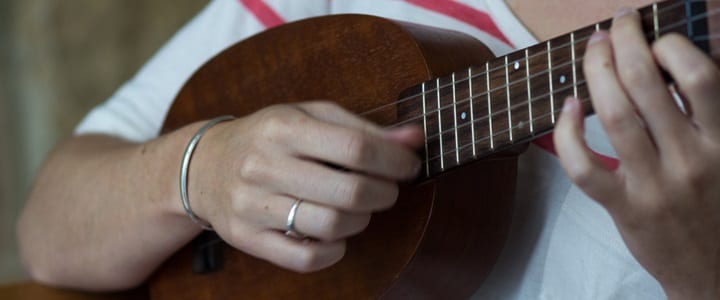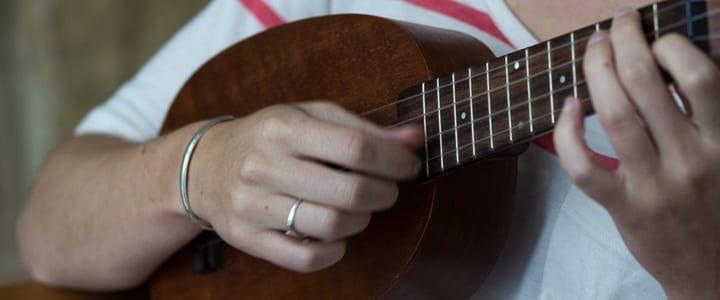 Learning to play the ukulele is tons of fun, but it comes with its own special challenges too. Music teacher Jonathan D. shares three difficulties beginners often face, plus the best ways to overcome them…
Learning to play the ukulele is tons of fun, but it comes with its own special challenges too. Music teacher Jonathan D. shares three difficulties beginners often face, plus the best ways to overcome them…
The ukulele is a fantastic instrument that’s relatively easy to learn how to play. However, like with any new skill, there can be a bit of a learning curve – especially when you’re first starting out.
In this blog post, we’ll take a look at six of the most common problems beginners face when playing the ukulele, and we’ll give you some tips on how to overcome them. Read on to learn more!
What Are the Difficulties You Have Encountered in Learning a Ukulele?
Learning to play any musical instrument can be challenging, and the ukulele is no exception:
- For one thing, it can be difficult to find the right teacher. Unfortunately, not all music teachers are created equal, and it can be difficult to find one who is both knowledgeable and patient.
- Learning the ukulele requires a certain amount of dexterity and coordination. Many people give up before they ever really get started because it takes time and practice to develop the necessary skills.
- Tthe ukulele can be a bit pricey, especially if you’re just starting out. While there are some less expensive options available, it’s important to remember that you get what you pay for. In other words, cheap ukuleles are often made of inferior materials and are not as easy to play.
All of these factors can make learning the ukulele a bit of a challenge. However, with patience and perseverance, anyone can learn to play this beautiful instrument.
Are you ready to get started? We’ve made the process of finding the right ukulele teacher a bit easier – all you need to do is sign up for lessons with TakeLessons! Check out the video below to learn more of the benefits of doing so:
https://www.youtube.com/watch?v=Q3LUngJmO9E
What Are Some Common Ukulele Problems?
For the enthusiastic beginner on the ukulele, a healthy dose of “try harder” in combination with a shiny new instrument may seem like a great start, but you may soon find you need to dig a bit deeper to conquer some of the stubborn difficulties of the instrument.
There are multiple categories of pitfalls the ukulele can present. First, there are general musicianship concerns such as reading notation and developing rhythmic coordination. Then there are the difficulties inherent to the ukulele. Last, there are the mental minefields you must navigate before mastering the ukulele. Let’s look at all three!
1. Keeping the Beat
Common to all instruments is need to recognize and master rhythmic structures. Beginning ukulele students face this problem immediately. At first it doesn’t seem like a big deal to play quarter notes, half notes, and whole notes. Most method books teach students to count quarter notes as one beat, half notes as two beats, and whole notes as four beats. Most teachers teach students to develop a system of counting beats. Unfortunately, many students promptly forget the importance of the beat. Fingering, reading notation, strumming, and many more concerns can cloud your mind as you learn how to play the ukulele and cause “rhythmic amnesia”.
The importance of keeping time cannot be overestimated. So how can you learn to stay on beat? There are several solutions that can be used alone or in combination. Using a metronome is at the top of the list. These days there’s no need to shell out $20 for a mechanical ticker at the local music store as a number of apps and online resources are available to the modern music maker.
Another solution to the enduring problem of rhythm is to isolate the rhythmic elements in a song and repeat them in your body until you habitually “feel” the rhythm of music. For example, if the introduction of eighth notes is causing you mental anguish, stand up and rock back and forth in time, coming down on alternate heels with each quarter note, and chant or clap twice for every beat. If you’re interested in exploring this method, TaKaDiMi is a superb option.
Perhaps the best approach to playing rhythmically is to find songs that are rhythmically enjoyable. After all, the real problem is usually a lack of motivation to find and maintain a beat. I’m always perplexed at musicians who leave out the best part of music making – the beat! Find songs that make people want to dance. Then enjoy playing them (along with metronome and TaKaDiMi work of course).
2. Getting to Know Your Uke
There are difficulties inherent in every instrument. When it comes to the ukulele, most of these are related to the connection between human and instrument – the fingers and the hand. At times the strings won’t vibrate well because of the amount of finger pressure. Fixing this problem could be helped by keeping your fingernails filed. Beyond grooming, keeping your thumb on the back side of the fretboard will help give your fingers a better angle of contact with the strings resulting in better control of the pressure they can, well, press with.
Another common frustration beginning ukulele students find is transitioning between chords quickly on the fretboard. Apart from finding efficient finger motions, one of the most effective solutions is practicing scales slowly, evenly, and daily. Scales provide the framework for chords, and after your fingers are comfortable navigating the scales, you are much more equipped to navigating the chords built on them.
3. Mental Mastery
Many ukulele students look for magical fixes for their technique when most of the answers can be found in your own mind already. The creative process is the key ingredient to learning technique, but the creative mind is often inhibited by fear.
For example, fear of hitting the wrong note makes you look down from the notation and onto the strings. The problem with this is that the information flow from the printed notes is interrupted, the mental learning process slows, and a mental “hiccup” occurs. Over time, you learn to pause and break focus. This habit is among the most inefficient mental habits in beginning students and creates mental murkiness. By maintaining your focus either on the printed music or on the fretboard, mental clarity is developed. Eye control leads to clarity, and clarity leads to better technical habits as you learn how to play the ukulele.
4. How Do I Know if My Ukulele Strings are Bad?
As any ukulele player knows, the strings are one of the most important parts of the instrument. Not only do they produce the sound, but they also affect the playability and tune of the ukulele. When strings become old or damaged, they can start to buzz or sound dull.
In some cases, they may even snap. If you suspect that your strings are bad, there are a few telltale signs to look for.
First, check for wear and tear. If the strings are frayed or discolored, it’s time to replace them. Next, take a close listen to the sound of your ukulele. If the tone is dull or muted, it’s likely that the strings are to blame.
Finally, pay attention to how the ukulele feels when you play it. If the strings feel loose or overly stretchy, it’s time for a new set. By keeping an eye out for these signs, you can ensure that your ukulele always sounds its best.
5. Why Does My Ukulele Keep Coming Untuned?
If you’ve ever found yourself wondering, “Why does my ukulele keep coming untuned?,” you’re not alone. In fact, it’s a pretty common problem for ukulele players of all levels.
There are a few different reasons why your ukulele might keep going out of tune, but the most common culprit is changes in temperature and humidity. When the air is dry, it can cause the wood to shrink, which means the strings will become tighter and higher in pitch.
Conversely, when the air is humid, it can cause the wood to expand, resulting in softer, lower-pitched strings. The good news is that there are a few simple things you can do to help keep your ukulele in tune, even in fluctuating conditions.
First, make sure you’re using high-quality strings that are properly stretched before each use. Second, invest in a humidifier if you live in a dry climate or a dehumidifier if you live in a damp area. By taking these simple steps, you can help ensure that your ukulele stays sounding great for many years to come.
6. Problem Ukulele Chords
One of the most common problems beginner ukulele players face is learning how to play chords. Chords are an essential part of playing the ukulele, and there are many different chords that can be used. While some chords are easy to learn, others can be more difficult.
One way to help make learning chords easier is to practice regularly.
Another way to help is to use a chord chart or diagram when practicing. This can help you visualize the chords and make it easier to remember the shapes. With a little practice, you’ll be playing chords like a pro in no time!
Tackle These Common Ukulele Problems By Getting Help From the Pros!
Learning how to play the ukulele can be loads of fun – but it’s not without its challenges! If you’re having trouble with messy strumming, hitting wrong notes, or unclear chords, don’t worry – you’re not alone. By following the tips in this blog post, you’ll be playing like a pro in no time!
Remember that above all else, enjoying the learning process by taking a positive, problem-solving approach will guide students at any level to conquer problems. There are always solutions for any difficulty encountered in learning how to play the ukulele.
For more help learning to play the ukulele, sign up for lessons with a private ukulele instructor. Ukulele instructors are available to help you in-person or online via Skype. Find your ukulele teacher today!
Jonathan D. is a singing instructor in Greenville, SC. He’s earned a BA and MM in vocal performance and has been teaching privately and in schools for more than 15 years. Learn more about Jonathan here!
Photo by aaron gilson
Megan L.


